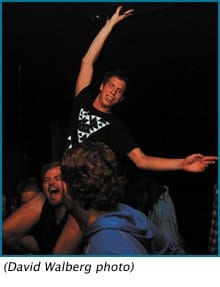
Credit: David Walberg photo
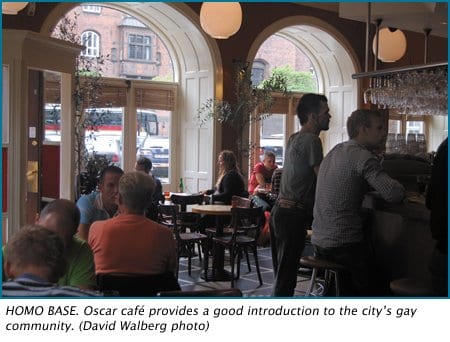
Credit: David Walberg photo
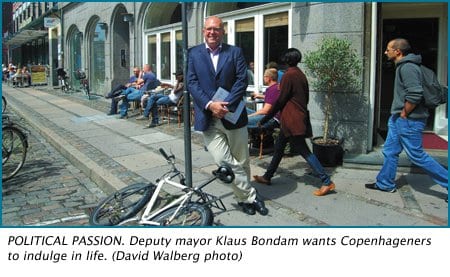
Credit: David Walberg photo
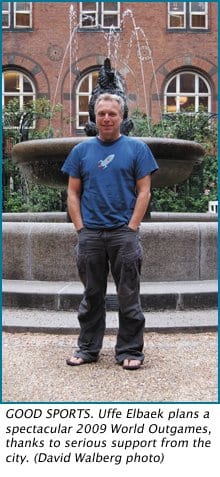
Credit: David Walberg photo
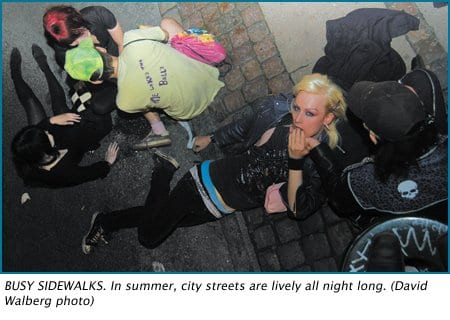
Credit: David Walberg photo
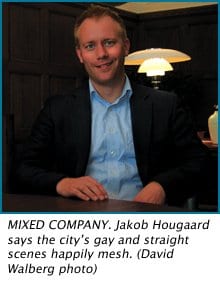
Credit: David Walberg photo
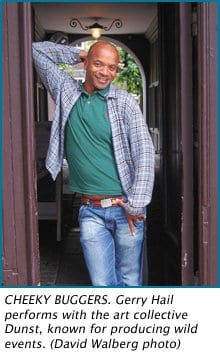
Credit: David Walberg photo
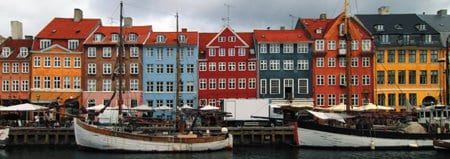
Credit: David Walberg photo

Credit: David Walberg photo
***
The small, snug bar called Dunkel is quite literally packed to the rafters: On a makeshift dancefloor, revelers clamber up one another’s backs to perch atop shoulders, hooting and hollering as they engage in treacherous double-decker dancing. It seems the raucous spirit of the Vikings lives on, even in Denmark’s more fashionable gay clubs.
Things are barely more subdued on the sidelines, where bulbous brushed-copper pendant lamps hover just above cocktail tables, like B-movie spaceships preparing to alight. Their warm glow reveals broad smiles stretching every pair of lips, save for those that yammer excitedly or mush against other pairs in passionate smooches. Cascades of laughter flow over the sounds spun by Djuna Barnes, the revered local lesbian DJ who has succeeded in raising the crowd to a fever pitch.
The rambunctious vibe spills onto the street outside. Partiers sit, stand and lie on the sidewalks, drinking beer, cracking jokes, dancing and making out. It’s approaching midnight, but the sky still radiates with sunset reds and oranges. A week after summer solstice, the abundance of sunlight hours can be disorienting and when Dunkel closes at 5am everyone agrees it seems way too early to go home.
By this time the sun has already risen after dipping just below the horizon for a few hours. The streets are full of the city’s party warriors. They are mostly young but also old; gay, straight and in-between; men, women and in-between; all basking in the triumph of another night vanquished.
***
Despite being perhaps the most sophisticated and modern people in the world, Scandinavians are deeply in tune with the ancient rhythm of the seasons. In summer they are blessed with clear skies and long, warm days. They respond with unabashed sun worship and all-night revelry.
Deputy mayor Klaus Bondam tells me it’s not just tradition that makes for Copenhagen’s reputation as an all-night party town. It’s also by design. The city encourages its citizens to fill the streets until the wee hours.
“We want more activity in the city, we want more energy in the city,” he says. “The Lord Mayor and I last year launched a project which we called — what would that be in English? — something like ‘Hit it, Copenhagen,’ or ‘Put the fire on, Copenhagen,’ where we looked at all the things that made it more difficult to have some life on the street, have bar seats on the street, to play music, to put up concerts or other events in the small squares and so on.”
Copenhagen already keeps late hours by North American standards. “You can either have a two o’clock permit or a five o’clock permit,” Bondam says, referring to the hour of the morning businesses must stop serving alcohol. More familiar to those of us on this side of the pond is the bureaucracy Bondam describes, which, he says, used to snuff the life out of urban initiative.
Bondam and I are chatting at Oscar, a charming gay café which he invokes to make his point. “If the owner of Oscar wanted to make a small concert out there,” he says gesturing to the public square just outside, “he had to fill out thousands of applications and talk to the police and talk to that department and this department. I mean, he was exhausted before he had ended that. That’s much easier now. We want to make it easier.”
***
***
Bondam is one of six deputy mayors — and one of two who are openly gay. He’s an animated man with a high profile; before he became a politician, he was one of Denmark’s best-known actors. Outside the country his most famous role is Helmut, the master of ceremonies in The Celebration, the Thomas Vinterberg film that launched the Dogme movement and became a surprise hit internationally.
On the morning of our meeting he has already been out to officially open the bathing season at a new beach. “I didn’t go in the water, I did it from the land. But I had some beautiful divers to open the facility for me,” he chuckles. Surrounded by shallow waters warmed by the Gulf Stream’s drift into the North Atlantic, Copenhagen enjoys a lively beach and aquatic culture.
The new facility features a 200-metre underwater diving track in the shape of a mermaid made of metal and stones, designed to attract and host all manner of sea life for the enjoyment of divers. “I think it’s very cool, I think it’s very modern,” he says. “I’m quite sure in a few years’ time, parts of it are going to be a gay hangout place as well.”
Representing such a lively city, it helps that Bondam enjoys a night on the town. “I’ve had some of my happiest moments in my life going out. I used to be quite a wild party boy,” he says.
“What I like and what I miss a lot, having grown older,” he confides, “is going to a bar or a disco, dancing and drinking all night and then walking home in the summer mornings when the lights are up and the bakery is open and you can go in and you can be drunk and buy a Danish pastry, and then go home, sleep for several hours, and then take the train to the beach.
“I think we were a bit wilder back then. I think times were a bit wilder,” he reminisces. “If there’s a thing that I don’t like today, it’s that there’s a certain fear of throwing yourself after things. I think I would say indulge more in life, don’t get so occupied with if you go to the gym that many times.
“Of course you have to do safe sex and all these things, but it’s not just a matter of sex, it’s a matter of going to the limit sometimes.”
Despite the city’s boisterous vibe, it’s clear Bondam is after something more: He wants the citizens of Copenhagen to experience an existential epiphany, to embrace freedom at the core of their beings. He urges his constituents to really let go: “Stop caring about how people might think you look, or just, I mean, get drunk if you want to get drunk or start screaming if you want to start screaming, or start laughing or start kissing people if you want to do that.
“I get a bit sad when I go out today. Well, I think it’s also the times. I mean, appearance is everything. You see a lot of people urging for stardom… stardom is the ‘in’ thing. It’s this whole American Idol thing.”
***
***
When you come to Denmark, you must get yourself invited to someone’s home for dinner. Danes love to entertain and so you won’t have to beg for invitations, but if you find yourself burdened by shyness, social ineptitude or foul body odours, not to worry: In Denmark, you can pay people to have you over for dinner.
A program called Dine with the Danes will set you up with a host; the Copenhagen branch even allows you to choose from “gay local host families” — hopefully ones that can cook.
I luck out with an invitation to the flat of Uffe Elbaek and his dashing husband, Jens Pedersen. Elbaek is the CEO of the Copenhagen Outgames, the queer sports, culture and activism extravaganza slated for July 2009. I marvel at their seemingly effortless hostly expertise, as they initiate ribald and incorrect conversations and moisten guests with a succession of wines and other intriguing intoxicants.
They light the room with dozens of candles, topped off by a candlelit chandelier above the dining table; the guests, glowing in the soft light, look so young that I fear I will start lactating and stain my new blouse.
My hosts have created an environment where, by the time we’ve finished eating, guests feel at ease enough to sing, dance and, in one instance, perform what appears to be a synchronized swimming routine on the flat’s smooth wooden floors.
I learn that achieving such a party atmosphere is a prized skill among the highly social Danes. They have a word for it: hygge, pronounced hu-geh, which has no English equivalent but which is often awkwardly translated as “coziness.”
Candles, wine and jokes are among the tools used to conjure hygge. (Danes are known as beer drinkers, but they are an oddly oenophilic bunch: they drink, per capita, as much wine as the wine-making Spaniards and significantly more than the neighbouring wine-making Germans; they double Swedish wine consumption, triple that of Canadians and quadruple that of Americans.)
The cozy physical setting and accoutrements are not as important to creating hygge as the quality of interaction these aids inspire. If you think of a favourite party or dinner and of the atmosphere that made it particularly special — when people really hit it off and the whole place seems to sparkle and hum with electricity — that’s hygge. It might better be understood as a quality of camaraderie and conviviality between friends or guests — comprised of animated conversations, intimate connections, warmth and general hilarity.
Fabulous dinner parties are not exclusive to Danish homes, of course, but the importance Danes ascribe to the art of socializing speaks to the larger Scandinavian orientation toward an odd constellation of values, which include collectivity, freedom and absurdity.
***
At dinner I sit beside a handsome, professional chap who initially strikes me as somewhat conservative. I ask him about Christiania, the famous Copenhagen quarter that declared itself a free state in the 1970s and exists to this day as a social experiment in anarchy. I have been looking, without luck, for someone who might agree with the conservative government’s plans to reintroduce Christiania into mainstream Danish society.
My new friend, however, is fiercely loyal to the experiment. He becomes philosophical as he explains why Christiania, which has few rules of its own design and makes decisions collectively, is important to everyone. He tells me the experiment allows us to ponder a question at the heart of all modern societies; as he puts it: “How do we want to live without the big eye looking down on us?”
“Christiania is kind of an icon for a lot of people in Denmark who have a more progressive outlook,” explains the Outgames’ Elbaek. “It’s an icon that, hey, don’t be so tight-up [uptight], and don’t be so business-like, and there’s more to life than profit.
“It’s a beautiful part of the city. It was an old army camp, and when the army went out, it was completely empty. And that was way back in the beginning of the ’70s. And then some people squatted the whole army camp. It’s a completely functional city in the city. It’s like the Vatican.”
Even the physical environment of Christiania is anarchic, and I have to admit that my first impression is that it contrasts poorly with the rest of the city. Copenhagen is so beautiful that I can’t imagine the desire for this ramshackle alternative. Perhaps in a small country, it expresses a yearning in the national soul for mayhem and wilderness, perhaps one formerly, at least mythically, provided by life on the high seas. Certainly, Christiania exemplifies the Danes’ preoccupation with freedom and innovation and their corollary distaste for the normal.
But normal is exactly what the current Danish government has in mind. It intends to replace the existing structure of collective property, impose taxes and open the gate for condo developers. “I think the government the last few years have made a strong effort in sort of normalizing society all the way through,” says Bondam. “And I think it’s so damn boring, to be honest.”
Among the government’s first forays has been a crackdown on the formerly liberal drug trade. Pot is still easily acquired in Christiania, but it was once sold openly and merrily. Now, one encounters the same guarded, furtive youth who might approach passersby on the main drag of any North American city, avoiding eye contact and speaking in code. The result is a big dent of fear in an otherwise easygoing atmosphere, a dent which may ultimately hinder Christiania’s allure for tourists, who have made the site the city’s second largest attraction, after the Tivoli amusement park.
***
In addition to its reputation as a great place to party and score drugs, I’m told that Christiania has birthed some successful solutions to confounding social conundrums. Its early recycling systems have been admired and copied elsewhere and, according to the UK daily The Independent, its approach to sewage filtration has put the commune on a shortlist for a pan-Scandinavian award for ecological living.
Bondam heralds the area’s integration of misfits. “Christiana is a very mixed society,” he says. “There are 600 people living out there: 200 of them are very, very strong, they have jobs, also high positions in society. Two hundred of them live in their own economy within Christiania… they have a special bicycle shop out there that makes some very special, very expensive bicycles; there’s an oven factory out there…
“Then there are 200, the last 200, they are junk heads, so, people who are mentally to a certain side. But what is great about Christiana is they are the only place in the city that’s actually been able to integrate these human wild cards, if you can put it that way.
“Four hundred straight people can live with 200 lunatics, and it goes on. I don’t mean it in a profane or negative way… but they are, you know, people who are really not in contact with this planet.”
Elbaek is optimistic that Christiania will prevail. “I think that there is a third way,” he says. “I think the government will find a solution, together with the people of Christiania. I hope so.”
Bondam is adamant. “We have to secure Christiana for future generations….” he asserts, “because it’s a symbol… it is maybe a symbol of the chaos, it’s a symbol of the anarchy, it’s a symbol of the freedom.”
***
***
Danish society is rare in that it is intrinsically progressive. Danes, it seems, are always on the lookout for doing things a better way, for living a better life. This quality expresses itself in everything from their approach to all manner of design — for which they are deservedly famous for innovation, functionality and beauty — to their approach to democracy, citizenship and human rights. They embrace change at precisely the points where other societies fear it. Their greatest fear, instead, is of being boring.
“I think it’s a challenge that every big city faces these years is the scary face of constant normality,” muses Bondam. “It’s a threat for every society and especially I think it’s a threat for city societies, because we’re very close to each other, we live very close, we look at people all the time. And if we get too scared, we tend to [want to] look like the other ones. Then, ‘I’m just like everybody else, and there’s nothing wrong with me.'”
Bondam is channelling Søren Kierkegaard, the famous philosopher who lived in Copenhagen almost 200 years ago. Kierkegaard, too, counselled Copenhageners to shun the crowd and embrace freedom; in the process, he birthed the concept that would become known as existential angst — the dreadful condition that afflicts us as we realize freedom’s truly terrifying, endless possibilities.
“I’m not very sort of controversial myself in any sense,” Bondam continues, “but what I really like about the city is the possibility of looking out on the street and seeing somebody who looks completely different from me, who lives a life which is completely different from mine, who takes completely different choices than I do…. They reflect my own choices: Do I make the right choices? Can I live my life in another way? And it makes me curious.
“The way I see it, it gives me also freedom to be gay in the city, the freedom to live my life.”
***
“Copenhagen has a very special place in gay history,” says Bondam from his café perch overlooking the city’s main square through huge windows. He waves his hand toward city hall, an unlovely building that looms over the square. “It was this house over here that held the first registered partnership in the world. The law today is copied in a lot of other places in the world.”
“The first transgender operation was in Denmark way back in ’47 or something like that,” says Elbaek (historians place the operation in 1952). Homosexuality was decriminalized in Denmark way back in 1930, although attitudes waxed and waned in the following decades. In 1961, male prostitution was criminalized if the prostitute was under 21; the Ugly Law, as it became known, was repealed in 1965 and male and female prostitution were equally legal by 1967, the same year that pornography was decriminalized.
The age of consent for gay and straight sex was set at 15 in 1976 and registered partnerships became legal in 1989.
“Denmark was the first country where a pornographic law was liberated,” continues Elbaek. “We were the first nation where you were allowed to have a partnership with your boyfriend or girlfriend. So for sure, it’s been a long tradition for people to create their own lifestyle.”
Jakob Hougaard is another of Copenhagen’s gay deputy mayors and, at 33, is the youngest mayor. “Denmark is known for being a very cozy place,” he tells me. “We don’t have in the Danish culture a very divided image of each other, actually we have in Denmark a very egalitarian culture. Being on the eye level of other people, and being on the same boat — those are metaphors for Danish culture, so that’s important values in Denmark.
“The gay community is not as segregated as I experienced in Toronto, where there is a part of the city with rainbows all over the place and every store and every boutique and bar was gay,” says Hougaard. “I think you will see it more mixed in Copenhagen and you will also see that as a gay you will also be going to straight bars with no problems.”
But does this welcoming attitude extend to other forms of nightlife? Bondam tells me of the city’s intervention in a gay cruising spot. “There’s an outside cruising area in one of the parks… and the city, they cut down some bushes, and there was a big roar in the gay community about that, because we were taking the ‘erotic oasis’ away from the city.”
Digging deeper, I discover the city’s intervention was perhaps somewhat workaday. “Of course you’re allowed to have sex if you don’t hurt anybody or you don’t disturb anybody,” explains Bondam. “But one of the problems up there in the park was also it is a playground during the day, and those guys, they left condoms out there. I mean, I don’t want to look at used condoms on the street, and children shouldn’t look on a used condom….
“If you want to have sex during the night, for Christ’s sake, clean up after your act. I’m very much a politician who’s into the responsibility thing. I mean, everybody has a responsibility for life in the city…. It takes millions and millions to pick this up. We could use this money for something else, if you just put it into the dustbin.”
***
“Both performers are singing while the one performer is actually fisting the other performer and pulling him around on a kind of a wagon during the show.”
Gerry Hail is describing a performance by members of Dunst, a Copenhagen queer art association. “We did this show here in Copenhagen and in Zurich, Switzerland… it’s done in such a way that you really feel that it’s an artistic performance and not just a kind of master pornography.
“I know it’s hard to imagine it but it’s really quite beautiful.”
But is it art? “I’m not sure that there’s any kind of particular statement other than that we can do whatever we want to,” says Hail. “I think that a lot of the Dunst energy is that there are no limits to what we are able to do creatively.”
Hail is an American who moved to Copenhagen 18 years ago and is now a Danish citizen. He attended the first meeting of Dunst in 2001, but didn’t take to the group right away. “Then, I thought that it was a bit too far out and too weird for what I could encompass in my lifestyle,” he says. “The whole experience has been very enriching in terms of being able to open up my mind.”
Dunst is known for both sexual provocation and humour; its name means “reek” or “stench” in Danish. Among other events, the group has produced art performances, parties and drag shows, often in combination. It has also produced a local television series and receives government funding. Hail performs as his drag alterego, Marilyn Not Monroe.
Dunst grew quickly, soon attracting hundreds to performances and garnering rave reviews in the mainstream press. Before long they were invited to perform in Berlin, Paris, Stockholm and Amsterdam. Today the association is somewhat fractured. Individuals and smaller groups have spun off to pursue their own paths as DJs, artists and performers.
Dunst remains an integral part of the Queer Festival, a week-long collection of art, music, screenings, workshops and parties held in Copenhagen every July.
“I would say a typical Dunst person is characterized as being rather artistic, maybe a student, not really fully employed and taking the position of social outcast,” says Hail. Refreshingly, the various Dunst characters I meet in Copenhagen are fun-loving and free of the pissy attitude and righteousness which can make self-styled queer radicals so tiresome elsewhere.
“For me the reason why it was very important to have this organization was that it was an opportunity or forum to be able to create or to experience or to live out new ideas and new ways of expressing creativity relative to sexuality,” Hail says.
“What you experience at the parties is that because of the freedom in which the Dunst people behave, it opens up possibilities for other people,” Hail explains. “So a lot of wild things happen at these parties, and they usually last until the very early hours of the morning and sometimes turn into afterparties. We’ve been thrown out of a lot of places and asked never to come back.”
One such place is Christiania. Dunst took over Gay House, a traditional queer hub in Christiania which had been abandoned. Hail describes Dunst’s tenure there as a “wild orgiastic affair.”
“I think Dunst was thrown out,” he says. “But fences have been mended since then and the community’s very small so people tend to squabble internally at times and get back together again.”
Hail isn’t sure what specifically led to Dunst’s expulsion, but he has some ideas. “Sometimes when they have these parties things do get broken or destroyed and then maybe the damage is too much.
“I know there was one show that one of our artists did in which he used his asshole as a kind of fountain so that he sprayed the crowd with water from his ass and a lot of people were offended by that. And then we were asked not to come back.
“So, there’s a little bit of everything happening at a Dunst show.”
***
“Three of my sisters are lesbian,” Bondam confides. “We’re five. There’s one straight.”
Coming out, then, was something of a homecoming. “It’s been a strong part of my family history, also because my grandfather was gay and his brother was also gay. So it’s always been an issue in my family and it’s also always been something that one talked about…. My parents, both my father and my mother, always said that somebody makes that choice in their life: Some people live like that, some people want that and of course that is acceptable.”
Both mayors’ personal coming-out stories support the idea of an integrated society. “Actually my family was the first I told,” says Hougaard. “It was fine. It was no problem. Gladly. Because that’s always a consideration, how they will react… I just hoped for the best. And they just want me to be lucky and happy and, well, I am, I think.”
Hougaard was more strategic in coming out to others. He told an acquaintance “who I knew would be very good at gossip… It’s easier to tell the one that just loves to tell the stories and then just sit back and wait for the history to get along.”
Bondam offers a story that suggests full acceptance of gay sexuality remains elusive, even in Denmark. “I had a funny experience last year,” he tells me. “There was a journalist who made a biography of me, which I partici- pated in, and we made a lot of interviews. I was not that happy with the book. But when I was younger, from [when] I was 15 to 30 or something, I made a list of whom I went to bed with and I told that journalist about that list. I mean, I thought it was just a curiosity.
“That list had in 15 years numbered to 110 men, which I think, I mean, come on! I really wasn’t that wild. And as one of my gay friends who is the same age as me said, ‘You could have done much better.’
“But what was interesting is that it made a sort of a huge public cry, ‘He’s been with 110 men, he’s so nasty,’ and I was like, ‘Come on!’ I’m a bit surprised that the Danish society still… was a bit prudish about that. And that shocked me a little bit.”
The two gay mayors insist their homo-sexuality has not been a hindrance to their careers and that gay issues do not make for controversy when politicians take them up. Indeed, the city of Copenhagen eagerly agreed to sign on as one of three partners producing the Outgames. City council, which includes members of the far right Danish People’s Party, voted unanimously to produce the event and fund it with almost $5 million.
“The whole gay issue is very seldom considered a problem, not on the political level,” says Bondam. “It might be… when you dig a little bit down from the surface. But if you were a politician today, a Danish politician talking against gay rights, I mean, you’d be dead. You’d be in deep shit, big trouble, sorry.”
***
Danes possess a sense of civic entitlement unique to Scandinavia. Even casual conversations reveal a profoundly democratic culture; people from all walks of life are active and engaged in shaping their society and social barriers seem relatively few.
Everyone — even the most perverted of homosexuals — assumes the right to be free, not just behind closed doors, but openly. It’s widely accepted that everyone ought to participate in public life and that even unconventional attitudes and activities ought to be represented in the public realm, with a share of public recognition, public funds and public space.
Danish queers have somehow managed to achieve both equality and difference — both sides of what remains, even for many of the world’s most liberated gay communities, a brutal trade-off.
A trip to Copenhagen allows visitors to bask in a unique environment of warmth and freedom, in a culture which inspires with its refreshing outlook and achievements.
David Walberg is publisher and editor at large at Pink Triangle Press, which publishes Xtra.ca. Check back soon for a feature about the 2009 Outgames.
NAVIGATING THE CITY
It’s rush hour in Copenhagen and traffic is heavy, but the air remains fresh and quiet. Gloriously absent are the smog and blasted horns one expects at this time of day.
At a busy intersection, several dozen bicycles have queued up alongside a mere handful of cars. Trim men and women in stylish business suits straddle their bike frames as they wait for the red stoplight to change, their briefcases stowed in baskets.
“Thirty-six percent of Copenhageners use their bicycle every day,” says deputy mayor Klaus Bondam. “Together with Amsterdam, we’re the only cities with these numbers.”
Visitors can take advantage of the city’s convenient coin-operated free bike programme. Drop in 20 Danish kroner (about $4) as a deposit, and you’ve got yourself a set of wheels. You’ll get your deposit back when you return the bike to one of more than a hundred racks around the city. While Paris recently made headlines for introducing an ambitious bike rental program, the Danes have been at it for a decade, with 2,000 free city bikes whizzing around town.
Cycling and walking are the best ways to see Copenhagen. Broad boardwalks line pretty canals and the harbour, leading you past a potpourri of architectural expressions, from medieval to modern. Lush parks are chock-a-block with impressive monuments as well as countless intriguing little sculptures you’ll stumble upon by surprise.
The Copenhagen skyline is spiked with tall church steeples, many of which can be climbed — some by narrow, spiral staircases that wrap around the spires’ exteriors, tapering ever narrower as they ascend — for breathtaking views of the city and the surrounding sea. You can easily see Malmo, the southern Swedish city now connected to Copenhagen by a bridge, which is an easy side trip.
The city also has an efficient transit system, including a slick new driverless subway.
FLIGHTS & HOTELS
If you connect via New York, you can start your Scandinavian experience early by flying SAS, where stylish details include Orrefors drinking glasses and Georg Jensen cutlery. A sample inflight magazine includes a six-page feature story about a Swedish lesbian; another issue recommends visiting Montreal for Pride.
From the Copenhagen airport, Central Station is a mere 20 minutes away via trains that run every 10 minutes. Steps from the station, just across from the entrance to the Tivoli amusement park, you’ll find Copenhagen Right Now, a helpful tourist information centre operated by the tourism authority Wonderful Copenhagen. The info centre and the train station sell the CPH card, a no-nonsense pass that gives you entry to 60 museums and attractions and access to public transit.
Admirers of mid-century Danish modern design will want to check out the SAS Radisson Royal Hotel, which opened in 1960. The legendary Arne Jacobsen designed the sleek hotel and produced some of his most iconic designs to furnish it. Enjoy a cocktail at the bar in an egg chair or a swan chair, or dine with the space-age AJ cutlery (so spacey it appears in the Stanley Kubrick film 2001: A Space Odyssey) in the penthouse restaurant.
For a more contemporary and affordable experience, The Square is a bright, airy hotel with modern but cozy rooms. Jacobsen egg chairs nest here, too; in crimson leather, they strike a sensual silhouette against stark white walls and clean, right angles. If this sounds like minimalist hotel hell, it’s not: the proportions are perfect and the effect, borne of Danish aesthetic expertise, is simply beautiful and pleasurable.
flysas.com
thesquarecopenhagen.com
USEFUL LINKS
Gay visitor info:
Events & Activities:
- dunst.dk
- queerfestival.org
- dinewiththedanes.dk
- meetgaycopenhagen.dk
- copenhagenpride.dk
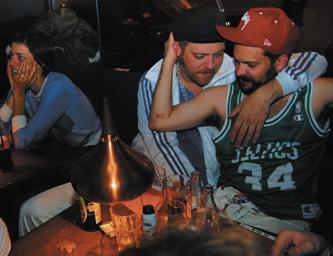
 Why you can trust Xtra
Why you can trust Xtra